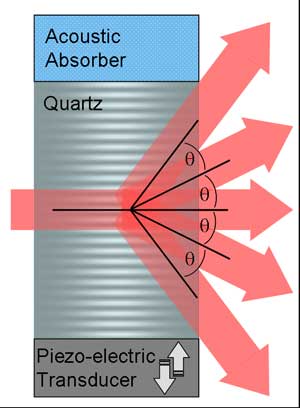.
Acousto-optic modulator

An acousto-optic modulator consists of a piezoelectric transducer which creates sound waves in a material like glass or quartz. A light beam is diffracted into several orders. By vibrating the material with a pure sinusoid and tilting the AOM so the light is reflected from the flat sound waves into the first diffraction order, up to 90% deflection efficiency can be achieved.
An acousto-optic modulator (AOM), also called a Bragg cell, uses the acousto-optic effect to diffract and shift the frequency of light using sound waves (usually at radio-frequency). They are used in lasers for Q-switching, telecommunications for signal modulation, and in spectroscopy for frequency control. A piezoelectric transducer is attached to a material such as glass. An oscillating electric signal drives the transducer to vibrate, which creates sound waves in the glass. These can be thought of as moving periodic planes of expansion and compression that change the index of refraction. Incoming light scatters (see Brillouin scattering) off the resulting periodic index modulation and interference occurs similar to in Bragg diffraction. The interaction can be thought of as four-wave mixing between phonons and photons. The properties of the light exiting the AOM can be controlled in five ways:
1. Deflection
A diffracted beam emerges at an angle θ that depends on the wavelength of the light λ relative to the wavelength of the sound Λ

in the Bragg regime and

with the light : normal to the sound waves, where m = ..., −2, −1, 0, 1, 2, ... is the order of diffraction. Diffraction from a sinusoidal modulation in a thin crystal solely results in the m = −1, 0, +1 diffraction orders. Cascaded diffraction in medium thickness crystals leads to higher orders of diffraction. In thick crystals with weak modulation, only phasematched orders are diffracted, this is called Bragg diffraction. The angular deflection can range from 1 to 5000 beam widths (the number of resolvable spots). Consequently, the deflection is typically limited to tens of milliradians.
2. Intensity
The amount of light diffracted by the sound wave depends on the intensity of the sound. Hence, the intensity of the sound can be used to modulate the intensity of the light in the diffracted beam. Typically, the intensity that is diffracted into m = 0 order can be varied between 15% to 99% of the input light intensity. Likewise, the intensity of the m = 1 order can be varied between 0% and 80%.
3. Frequency
One difference from Bragg diffraction is that the light is scattering from moving planes. A consequence of this is the frequency of the diffracted beam f in order m will be Doppler-shifted by an amount equal to the frequency of the sound wave F.
![]()
This frequency shift is also required by the fact that energy and momentum (of the photons and phonons) are conserved in the process. A typical frequency shift varies from 27 MHz, for a less-expensive AOM, to 400 MHz, for a state-of-the-art commercial device. In some AOMs, two acoustic waves travel in opposite directions in the material, creating a standing wave. Diffraction from the standing wave does not shift the frequency of the diffracted light.
4. Phase
In addition, the phase of the diffracted beam will also be shifted by the phase of the sound wave. The phase can be changed by an arbitrary amount.
5. Polarization
Collinear transverse acoustic waves or perpendicular longitudinal waves can change the polarization. The acoustic waves induce a birefringent phase-shift, much like in a Pockels cell. The acousto-optic tunable filter, especially the dazzler, which can generate variable pulse shapes, is based on this principle[1].
Acousto-optic modulators are much faster than typical mechanical devices such as tiltable mirrors. The time it takes an AOM to shift the exiting beam in is roughly limited to the transit time of the sound wave across the beam (typically 5 to 100 nanoseconds). This is fast enough to create active modelocking in an ultrafast laser. When faster control is necessary electro-optic modulators are used. However, these require very high voltages (e.g. 10 kilovolts), whereas AOMs offer more deflection range, simple design, and low power consumption (less than 3 watts).
Application
* Q-switching
* Regenerative amplifiers
* Cavity dumping
* Modelocking
* Laser Doppler vibrometer
See also
* Electro-optic modulator
* Jeffree cell
* Photoelasticity
* Pockels effect
References
1. ^ H. Eklund, A. Roos, S. T. Eng. Rotation of laser beam polarization in acousto-optic devices. Optical and Quantum Electronics. 1975;7(2):73–79. doi:10.1007/BF00631587.
Retrieved from "http://en.wikipedia.org/"
All text is available under the terms of the GNU Free Documentation License

